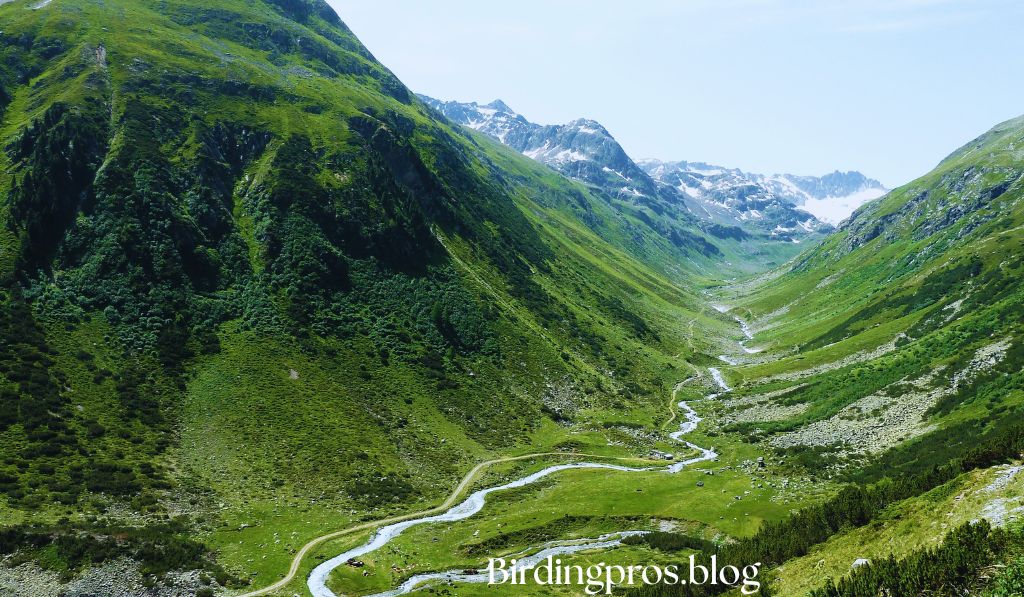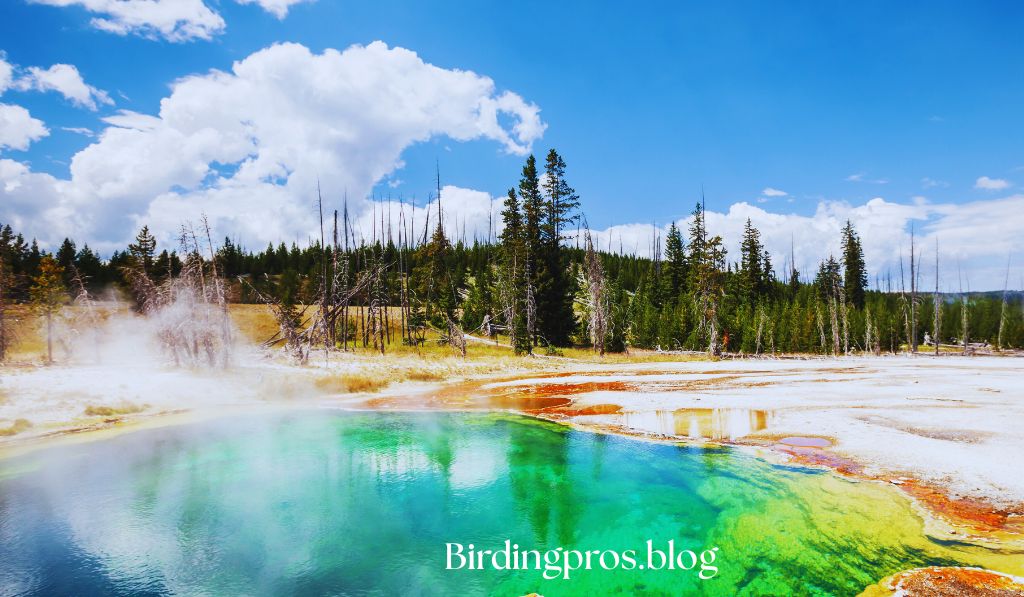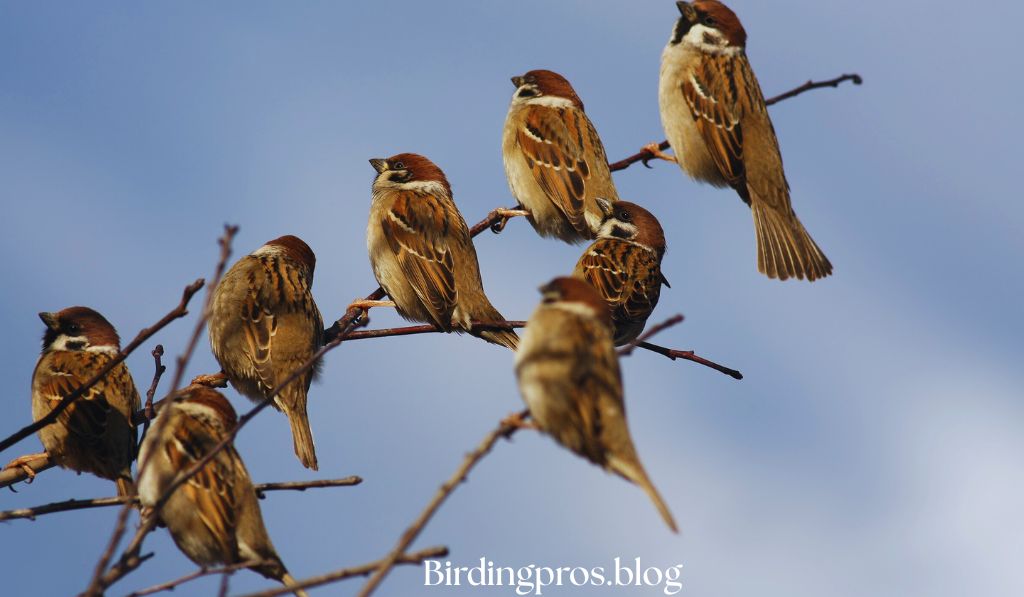Yellowstone National Park gives a number of the most extremely good birding opportunities in North America.
With over 300 species documented inside its obstacles, Yellowstone birding draws lovers from around the area looking to enjoy its incredible avian variety.
The park’s several ecosystems – from alpine meadows to river valleys – create ideal habitats for resident and migratory birds alike, making Yellowstone birding an unforgettable adventure for nature fans of all enjoy ranges.
Table of Contents
ToggleIntroduction to Yellowstone National Park
Yellowstone National Park stands as America’s first national park, hooked up in 1872 to hold its unique geological functions and adequate plants and fauna.
While many site visitors come for the geysers and big mammals, Yellowstone birding opportunities remain one of the park’s nice-stored secrets and techniques.
Historical Significance
Yellowstone has played a pivotal characteristic in conservation records, placing a precedent for shielding herbal regions globally.
The protection efforts that started out here have right now benefited Yellowstone birding via preserving pristine habitats critical for avian populations to thrive.
Over the decades, park manipulation has more and more recognized the importance of hen conservation, making Yellowstone birding a challenge in environment control plans.
Ecological Diversity
The park encompasses approximately 2.2 million acres of various terrain, growing a couple of ecological zones that help Yellowstone birding at some point of the year.
From excessive mountain forests to riparian corridors, every zone hosts particular bird groups tailored to its particular situations.
This ecological range explains why Yellowstone birding lovers can study the whole thing from water-loving American dippers to coniferous woodland professionals like Clark’s nutcrackers in an unmarried go to.
Accessibility for Birders
Despite its far flung wilderness, Yellowstone gives amazing accessibility for birding lovers. Well-maintained roads offer right of entry to top Yellowstone birding places, while boardwalks and trails allow site visitors to discover several habitats effectively.
The park’s infrastructure makes Yellowstone birding available to people of all ages and physical abilities, although venturing onto less-traveled paths can reward severe birders with particular sightings.
The Essentials of Yellowstone Birding
Successful Yellowstone birding requires schooling and know-how. Understanding at the same time as and wherein to look dramatically increases your chances of memorable bird encounters.
Best Seasons for Yellowstone Birding
Spring migration brings an explosion of bird hobby to the park, making April via June prime time for Yellowstone birding. During those months, resident birds establish territories and build nests whilst migratory species skip through in waves.
Summer (June-August) represents the height of Yellowstone birding season even as birds are raising younger and more active.
Fall migration (September-October) gives opportunities to spot species passing via, at the identical time as wintry weather Yellowstone birding rewards hardy observers with sightings of twelve months-spherical citizens like ravens, eagles, and chickadees.
Essential Equipment
Quality binoculars shape the inspiration of any Yellowstone birding package. Invest in the first-class pair you can find the cash for, preferably with 8×42 or 10×42 magnification for most effective viewing.
A situation manual precise to Western birds facilitates identification, whilst a recognizing scope proves precious for watching waterfowl and raptors at a distance.
Don’t forget weather-suitable clothing – Yellowstone birding situations can alternate unexpectedly, even in summer season. Unlike backyard fowl looking, you can now not discover hen feeders in Yellowstone, as synthetic feeding disrupts natural behaviors and can create volatile flora and fauna dependencies.
Birding Ethics in the Park
Responsible Yellowstone birding approach setting birds’ welfare first. Maintain the right distance from nests and sensitive habitats, and in no manner use recordings to draw birds all through the breeding season.
Stay on distinct trails inside the direction of your Yellowstone birding expeditions to minimize habitat disturbance.
Photography need to by no means take precedence over the birds’ fitness – no image is really well worth stressing wildlife. These moral practices make sure Yellowstone birding stays sustainable for generations to return.
Prime Locations for Yellowstone Birding
Yellowstone’s considerable panorama offers several hotspots wherein birding opportunities abound. Knowing wherein to consciousness your efforts maximizes your chances of various sightings.
Hayden Valley

Hayden Valley represents one of the crown jewels of Yellowstone birding. This expansive grassland valley, bisected by the usage of the meandering Yellowstone River, attracts diverse hen species all through the yr.
What Makes It Special
The valley’s combination of wetlands, river habitat, and open meadows creates a perfect typhoon of variety for Yellowstone birding enthusiasts.
The ample food assets, from aquatic invertebrates to seeds and berries, assist birds at each level of the meals chain.
While outdoor chicken feeders might concentrate birds in suburban settings, Hayden Valley’s natural meals property creates organic congregation factors for birds which may be amazing to look at.
Notable Species
Hayden Valley offers first-class possibilities for watching trumpeter swans, sandhill cranes, and white pelicans in the route of your Yellowstone birding adventures.
Lucky observers might spot bald eagles and ospreys looking alongside the river, while the grasslands host vesper sparrows and savannah sparrows. Morning and night time hours usually yield the maximum active Yellowstone birding in this vicinity.
Lamar Valley

Often known as “America’s Serengeti,” Lamar Valley’s reputation extends beyond huge mammals to great Yellowstone birding opportunities.
Landscape Features
The valley’s combination of river corridors, riparian woodlands, and open grasslands creates several microhabitats best for Yellowstone birding. The Lamar River itself attracts numerous species that depend upon aquatic ecosystems.
While suburban birders might use fowl feeders to attract site visitors, right here the natural landscape serves as nature’s bird feeder, concentrating avian hobby spherical natural food resources.
Bird Diversity
Lamar Valley excels for raptor statements all through Yellowstone birding tours. Golden eagles, prairie falcons, and hard-legged hawks patrol the skies, while northern harriers glide low over grasslands looking for prey.
The river area hosts belted kingfishers, noticed sandpipers, and every now and then American dippers.
Dawn Yellowstone birding lessons often display mountain bluebirds flitting thru sagebrush as they start their day by day activities.
Blacktail Plateau Drive

This scenic 6-mile one-manner power gives remarkable Yellowstone birding opportunities in a more forested environment than the valleys.
Forest Birding
The blended coniferous wooded area along Blacktail Plateau hosts several wooded region specialists, making it an critical stop at some point of any Yellowstone birding itinerary.
Unlike open regions, wooded vicinity birding calls for staying power and keen listening competencies to discover birds in some of the bushes.
While suburban birders may use chicken feeders to supply wooded vicinity birds into view, proper here you’ll need to boost your statement talents to identify them in their herbal setting.
Yellowstone Lake

As the biggest excessive-elevation lake in North America, Yellowstone Lake creates particular Yellowstone birding possibilities centered on spherical aquatic environments.
Shoreline Exploration
The huge coastline gives numerous habitats for efficient Yellowstone birding, from sandy beaches to marshy coves.
Walking segments of the shoreline famous awesome chicken groups tailor-made to unique conditions.
While bird feeders may additionally listen to birds in out of doors settings, right here the lake itself serves as a natural feeding station, drawing in various species.
Notable Yellowstone Birding Species
While over three hundred species were documented, certain birds stand out as iconic representatives of Yellowstone birding reports.
Raptors
The park’s numerous landscapes are a useful resource and super array of birds of prey, making raptor remark a spotlight of many Yellowstone birding adventures.
Bald Eagles
America’s national image features prominently in Yellowstone birding checklists. Bald eagles preserve territories near lakes and rivers in which they hunt for fish and waterfowl.
Their massive nests, used twelve months after 12 months, end up with terrific skills in the panorama.
Unlike suburban settings wherein chicken feeders could possibly from time to time trap small raptors, Yellowstone’s eagles rely absolutely on herbal searching abilities to live to inform the tale.
Ospreys
These specialized fish-hunters represent a common sight in the route of summer time Yellowstone birding tours.
Their unique dive from heights of 30-100 ft provides genuinely certainly one of nature’s maximum dramatic fishing shows.
Ospreys assemble large platform nests to stop snags and rocks, many visible from park roads for accessible Yellowstone birding statements.
Water Birds
The park’s rivers, lakes, and wetlands assist numerous aquatic chicken corporations that function prominently in Yellowstone birding research.
Trumpeter Swans
North America’s biggest waterfowl species represents a conservation fulfillment tale and spotlight of many Yellowstone birding journeys.
These majestic birds may be determined year-round, as a few people stay through wintry climate on ice-loose portions of rivers.
Their resonant calls bring in the course of valleys, pronouncing their presence earlier than visible affirmation at some point of Yellowstone birding outings.
Forest and Meadow Birds
The park’s various terrestrial habitats host several songbirds and woodpeckers that offer rich opportunities for Yellowstone birding all through accessible regions.
Clark’s Nutcracker
This smart corvid plays an essential ecological feature in Yellowstone’s forests and competencies prominently on many birders’ target lists.
The nutcracker’s outstanding spatial reminiscence permits it to cache hundreds of whitebark pine seeds and retrieve them months later, making it an vital dispersal agent for this threatened tree species.
While some birds effectively adapt to suburban chook feeders, Clark’s nutcrackers keep their crucial ecological relationships in Yellowstone’s wild landscapes.
Seasonal Yellowstone Birding Guide

Each season brings precise Yellowstone birding possibilities as chicken corporations shift with converting conditions.
Spring: The Migration Explosion
Spring represents perhaps the most dynamic season for Yellowstone birding as iciness citizens go away, summer season residents arrive, and migrants bypass thru.
Early Spring (April-May)
As snow started melting, early migrants moved back to start the Yellowstone birding calendar. Mountain bluebirds often seem first, bringing splashes of shade to snowy landscapes.
Waterfowl begin moving thru in waves, preventing at newly opened water. While suburban hen feeders would likely see seasonal shifts in website site visitors, Yellowstone’s migration patterns comply with historic rhythms tied to herbal meals resources and breeding cycles.
Summer: Breeding Season
Summer transforms Yellowstone right right into a nursery, offering unique possibilities to take a look at breeding behaviors all through your birding expeditions.
Nesting Activities
Summer Yellowstone birding frequently well-known shows captivating nesting behaviors at some point of species.
From osprey structures seen on prominent snags to killdeer performing damaged-wing presentations to distract predators from their floor nests, breeding season brings drama and motive to bird observations.
Unlike the controlled environment of out of doors chook feeders, here you witness the general spectrum of natural breeding behaviors.
Fall: Migration Returns
Fall brings each other waves of movement as birds put together for wintry weather, developing dynamic Yellowstone birding opportunities from August through October.
Early Fall Movements
Hawks and eagles function prominently in fall Yellowstone birding as they migrate alongside mountain ridges.
Berry-generating shrubs enchantment to thrushes and waxwings fueling up for migration journeys.
Unlike the year-spherical reliability of backyard bird feeders, those natural feeding areas show seasonal pulses of abundance tied to fruit ripening cycles.
Winter: The Specialists
Winter Yellowstone birding showcases hardy one year-spherical residents and site visitors in particular tailored to harsh situations.
Resident Species
Ravens, Clark’s nutcrackers, and chickadees display wonderful adaptations for the duration of wintry weather Yellowstone birding observations.
These everlasting citizens have superior physiological and behavioral techniques to stay to inform the story of excessive bloodless and restricted meals resources.
While suburban birds could likely rely on chicken feeders for the duration of winter, Yellowstone’s residents rely actually on natural meal substances and saved caches.
Winter Visitors
Rough-legged hawks and northern shrikes on occasion seem for the duration of wintry weather Yellowstone birding excursions, having migrated from Arctic breeding grounds.
American dippers come to be greater conspicuous alongside unfrozen pass sections, their darkish paperwork contrasting with snowy banks and icy waters.
These specialised winter birds screen nature’s outstanding adaptability to excessive conditions.
Conservation and the Future of Yellowstone Birding
The future of Yellowstone birding depends on ongoing conservation efforts to protect habitat and address emerging threats.
Climate Change Impacts
Climate alternate poses extraordinary demanding conditions to hen populations which have an effect on Yellowstone birding possibilities.
Shifting Ranges
Researchers have documented variety shifts in many species relevant to Yellowstone birding, with a few shifting northward or to better elevations as temperatures grow.
These shifts adjust community compositions and ecological relationships, potentially converting which species birders stumble upon during future visits.
Unlike the managed surroundings of out of doors bird feeders, those natural systems ought to adapt to big-scale environmental modifications.
Habitat Protection Efforts
Ongoing habitat safety represents the foundation of sustainable Yellowstone birding opportunities.
Fire Management
Yellowstone’s hearth control rules at once affect hen habitat and thereby have an effect on Yellowstone birding research.
Park managers apprehend that fireplace plays a herbal function in preserving habitat variety, reaping advantages species like black-sponsored woodpeckers focusing on presently burned forests.
This ecological knowledge guarantees various habitats stay to be had for effective Yellowstone birding.
Invasive Species Control
Controlling invasive flora and animals permits hold natural ecological relationships vital for real Yellowstone birding reviews.
Native plant groups assist particular insect populations that many birds rely on—relationships that may be disrupted whilst non-local species invade.
Unlike the artificial feeding relationships at chicken feeders, those natural food webs require intact native ecosystems.
Conclusion: The Lasting Value of Yellowstone Birding
Yellowstone birding gives greater than just amusement charge—it connects us to large natural patterns and conservation desires.
As you develop your Yellowstone birding abilities, you gain appreciation for ecological relationships that maintain these various bird groups.
While chook feeders may entice birds to your outside, now nothing compares to looking at these excellent creatures in their herbal habitats, behaving as they have for millennia.
The park’s protection guarantees that destiny generations can enjoy the same Yellowstone birding opportunities we cherish today.
Every birding experience will become no longer just a private journey but a contribution to the collective appreciation that sustains conservation efforts.
Whether you’re a first-time tourist or a seasoned Yellowstone birding fanatic, the park’s avian residents and migrants have something new to educate about version, resilience, and the interconnectedness of all living matters.
Related posts
1. How To Set Up Bird Feeders In Backyard: Step-by-Step Guide
2. Best Birding Lodging in Panama: The Ultimate Guide to Top 10 Destinations






